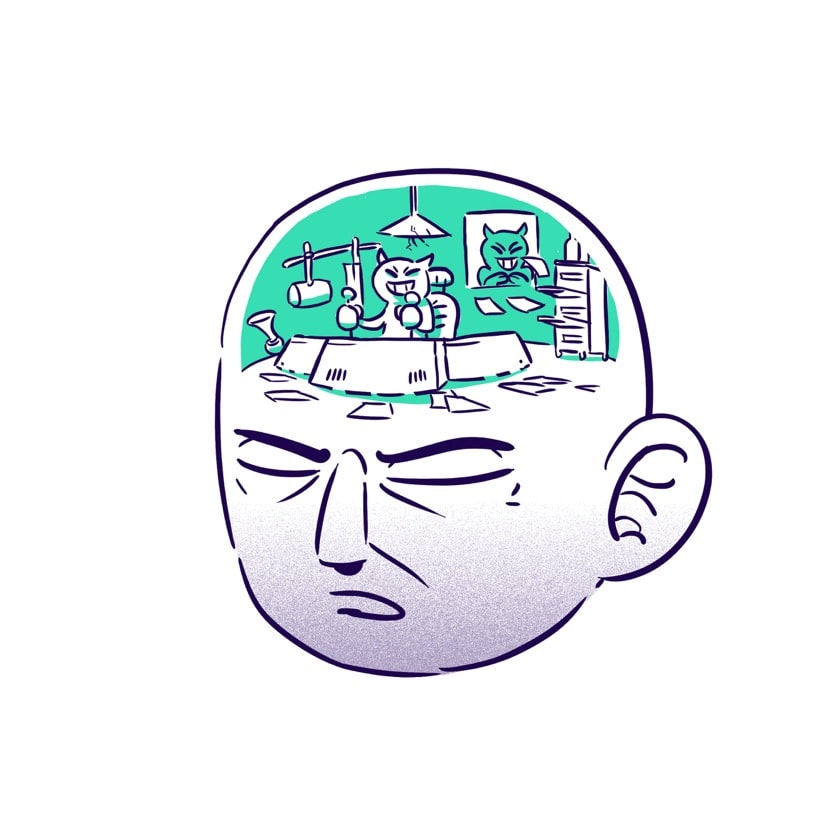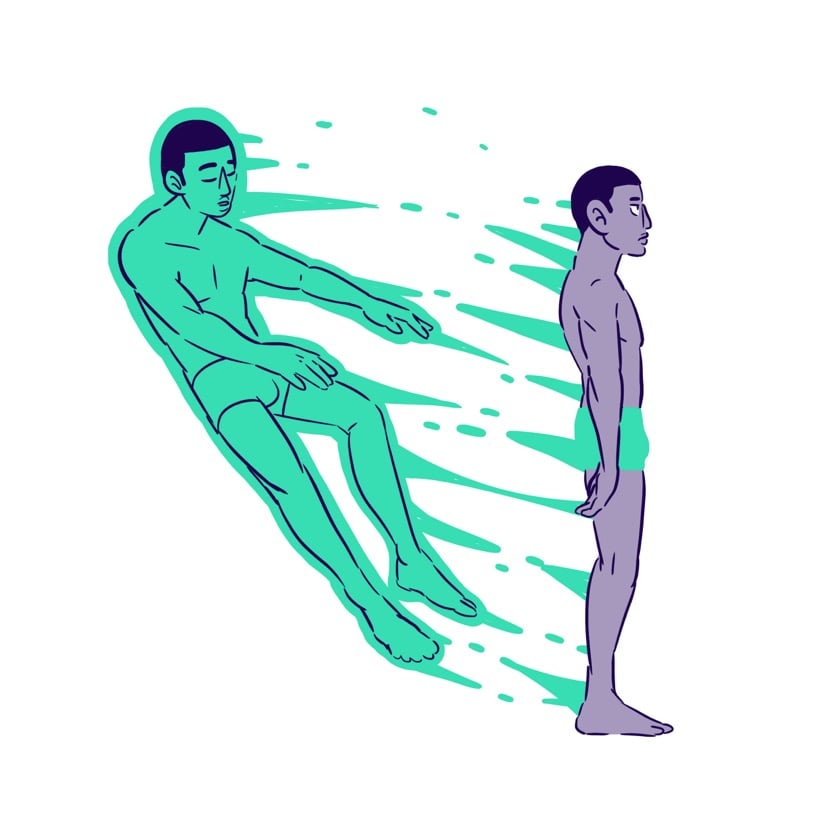Undesirable events around our sleep, or when parasomnias bother us
They know how to be discreet but often end up imposing themselves in our sleep. They are generally not dangerous for us, poor sleepers, but they cannot leave us indifferent (if not letting us sleep peacefully), here we address the famous parasomnias. "Para" ("beside") and "Somnie" ("sleep") are one and the same and paradoxically do not remain "aside" at bedtime, as these sleep disorders can intrude into our nights without us realizing or remembering it. Not very nice, these parasomnias!

What is a parasomnia?
A parasomnia is a sleep disorder, just like insomnia or hypersomnia, for example, with the difference that a parasomnia involves an abnormal motor or psychomotor behavior during sleep, or at the boundary between sleep and wakefulness. Not clear? Let's take an example. Sleepwalking is the perfect illustration of what is called an undesirable event (meaning "abnormal motor or psychomotor behavior") occurring during sleep: the person affected makes movements, seems awake, sometimes moves around, all while being unaware of what they are doing. This is what a parasomnia corresponds to and, as we will see just after, there are several types with different characteristics.
A category apart within sleep disorders, the different parasomnias share the common feature of being characterized by undesirable and unique behavioral or psychic events, but also occurring unconsciously for the people affected (except for nightmares). A parasomnia, whatever it may be, is the result of a dissociation between wakefulness and sleep states of consciousness. Since we are talking about several parasomnias, you are probably wondering how many there are. So what are the different types of parasomnias and how are they distinguished?
First of all, know that parasomnias are distinguished from each other based on the sleep phase during which they occur. Parasomnias are thus classified into 3 main types:
- Deep slow-wave sleep parasomnias : sleepwalking, night terrors, confusional arousals
- REM sleep parasomnias : recurring nightmares, sleep paralysis, catathrenia, REM sleep behavior disorder (RBD)
- Slow-wave and REM sleep parasomnias : sleep-related eating disorder, sexsomnia, parasomnia overlap syndrome, sleep enuresis
Slow-wave sleep parasomnias are the most "common" and tend to affect children more than adults. Their prevalence is estimated at 4 to 17% of children and 2 to 4% of adults1.
The main causes of parasomnias are linked to external factors disrupting the quality and duration of sleep, but sometimes also to a genetic factor2. Here are some of the causes of parasomnias:
- stress, anxiety
- alcohol consumption, drug use
- emotional shock, fever
- lack of sleep, jet lag
- genetic factor
- intensive competitive sports practice
As a general rule, parasomnias do not pose a real health risk, except in some cases, sleepwalking. However, parasomnias can cause certain daily inconveniences and have physical, even moral repercussions on the affected individuals as well as on their surroundings. Here are the main consequences of parasomnias:
- poor sleep quality
- risks of physical injuries (to oneself and others)
- increased fatigue
- anxiety, shame
- disturbance of the sleep of those around
Here is an overall view of what parasomnias are and the characteristics they share. As you might guess, it's not the best company to spend your nights with! It's now time to make a few stops to quickly present the main parasomnias. Are you still following the route of our night GPS?
Sleepwalking: a stroll without leaving your sleep bubble!
Are there any Latin scholars in the audience? Literally, somnambulism means "to walk while sleeping", which in itself already sums up quite well this peculiar sleep disorder. Indeed, a sleepwalking episode leads the individual to wander and perform various actions (walking, cleaning objects, eating…) while unconscious.
Sleepwalking corresponds to a dissociated (or incomplete) state of wakefulness: the sleepwalker shows motor activity while sleeping, even if their eyes are open, and will not remember their actions upon waking. Sleepwalking episodes can last from 5 to 30 minutes, sometimes less, and sometimes consist of a simple action (glancing around, sitting on the bed, touching objects, walking) or more complex and dangerous actions such as:
- going down stairs, opening a door
- accessing cupboards, fridge, or other storage
- eating, drinking, cooking
- handling objects
- leaving home, driving
The estimated prevalence of sleepwalking3 is 2% for adults, but children are more affected by this parasomnia since more than 5% of them are said to experience sleepwalking episodes.
If you want to learn more about this unconscious nighttime stroll, which is actually restful (yes, we walk while sleeping!), this is the place to be!
Night terrors
Their name doesn't really inspire enthusiasm, we agree. And for good reason. Night terrors are a parasomnia of deep slow-wave sleep, meaning they occur at the beginning of the night, during the first 3 hours of sleep. They are similar to sleepwalking because they happen early in the night, but also because of the physical manifestations they cause.
Indeed, during a night terror episode, the individual exhibits typical signs of fear, such as screaming, sweating, very agitated movements, or rapid breathing. This can be very "spectacular" and worrying, especially for parents, but it remains without particular danger. This phenomenon mainly affects children, nearly 5% of them4, primarily between 3 and 6 years old.
Just like with sleepwalking, the child suffering from night terrors has no memory of them once awake, and maybe that's for the best, right? For scholars who want to know more about night terrors, it's right here!

Nightmares: movies throughout the night!
Here is one of the best known and most popular sleep disorders. Popular, not because we love it, but rather in the sense that it affects a large number of people, to varying degrees. Nightmares occur at the end of the sleep cycle, during the REM sleep phase. We can say that nightmares "play out," as events worthy of the best Hollywood movies can unfold in some of them!
A nightmare is actually our brain's response to stress and difficulties we may face daily. They have a regulatory and cathartic function to help us confront our fears! It is therefore perfectly normal to have nightmares. The prevalence of so-called "recurrent" nightmares, that is, at least once a week, is estimated at 5% of the general population5.
However, when nightmares are daily, they become pathological and can then be symptomatic of a psychological disorder. Unlike night terrors or sleepwalking, it is quite common to remember one's nightmares upon waking.
For those who want to know what really lies behind nightmares, and what their real meaning is, go right here to discover the behind the scenes of the film "why do we have nightmares".
Other parasomnias
Here, in a few words, is a brief presentation of other parasomnias, which are generally relatively less common:
- sleep paralysis: it is a sleep disorder, a symptom of narcolepsy, during which one is unable to move while being conscious, sometimes for several minutes, and which can be accompanied by hallucinations
- catathrenia: it is a benign sleep disorder characterized by the emission of sounds during sleep, such as grunts or moans, which can last several minutes, or even repeat several times during the night
- confusional arousals: this sleep disorder is common in young children, less so in adults (about 4% of the population), and is characterized by disorientation upon waking, with a loss of temporal and spatial orientation, as well as behavioral inconsistencies, all of which can last about ten minutes
- sleep-related eating disorder: this relatively rare parasomnia involves a neurophysiological disorder, similar to sleepwalking, that leads the individual to eat during sleep, unconsciously!
- sexsomnia: this is a parasomnia related to sleepwalking in which the person affected exhibits sexual behavior unconsciously, which can lead to involuntary sexual acts towards a partner or other people around them
Parasomnias are therefore undesirable and most often unconscious events, as we have seen, which we would gladly do without to improve our nights! However, most of them are not dangerous and, fortunately, the person suffering from a parasomnia almost never remembers them. It is the close entourage who can unfortunately suffer from them, to some extent.
It is nevertheless true that psychological and moral suffering can develop in some people affected by parasomnia. Indeed, a feeling of guilt and/or frustration, even if unjustified, can lead an individual to blame themselves for their “undesirable behaviors” caused by their sleep disorder as well as for the repercussions caused to those around them, or to themselves, even though this is beyond their control...
Sources:
[1] Night terrors, sleepwalking, and confusional arousals in the general population: their frequency and relationship to other sleep and mental disorders, M M Ohayon , C Guilleminault et al, « The Journal of Clinical Psychiatry », April 1999 [2] Prevalence and genetics of sleepwalking: a population-based twin study, C Hublin , J Kaprio et al, « Neurology », January 1997 [3] Prevalence of Sleepwalking: A Systematic Review and Meta-Analysis, Mark Kohler, « Plos One », November 2016 [4] Sleepwalking, Nightmares, and Night Terrors in Children, site « Fondation Sommeil », 2020 [5] Prevalence and Correlates of Frequent Nightmares: A Community-Based 2-Phase Study, Shirley Xin Li, Bin Zhang et al, « Sleep », June 2010
